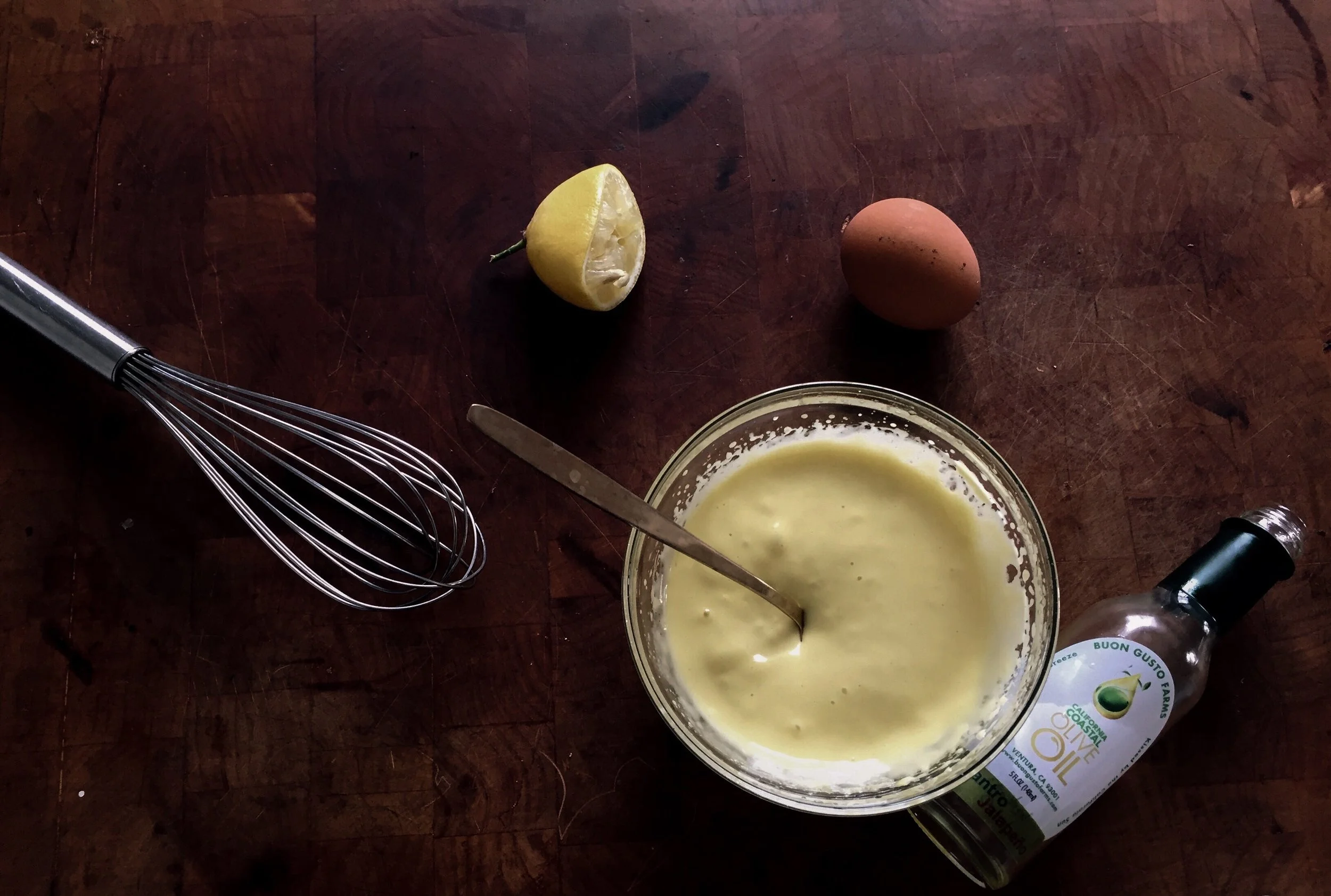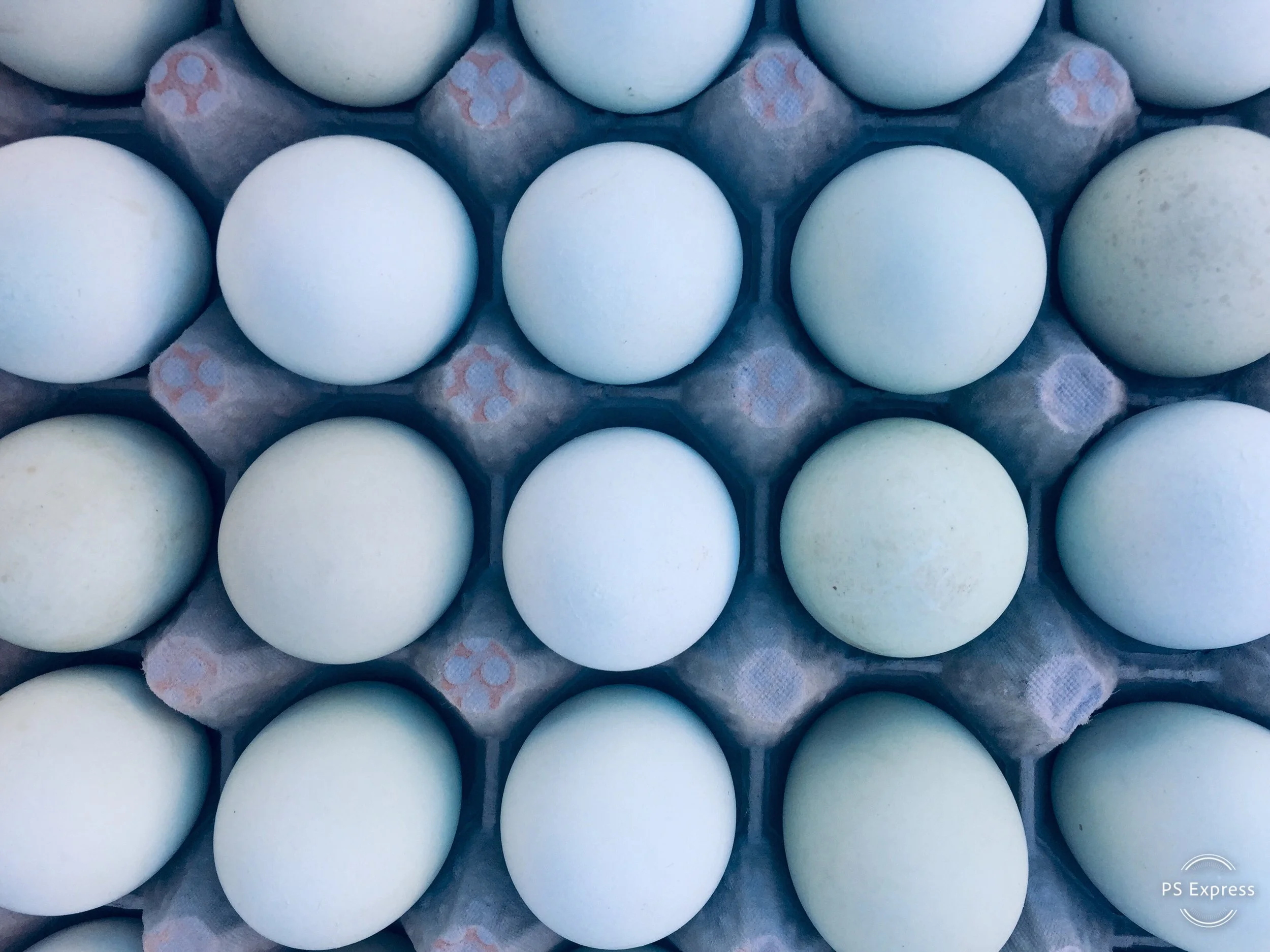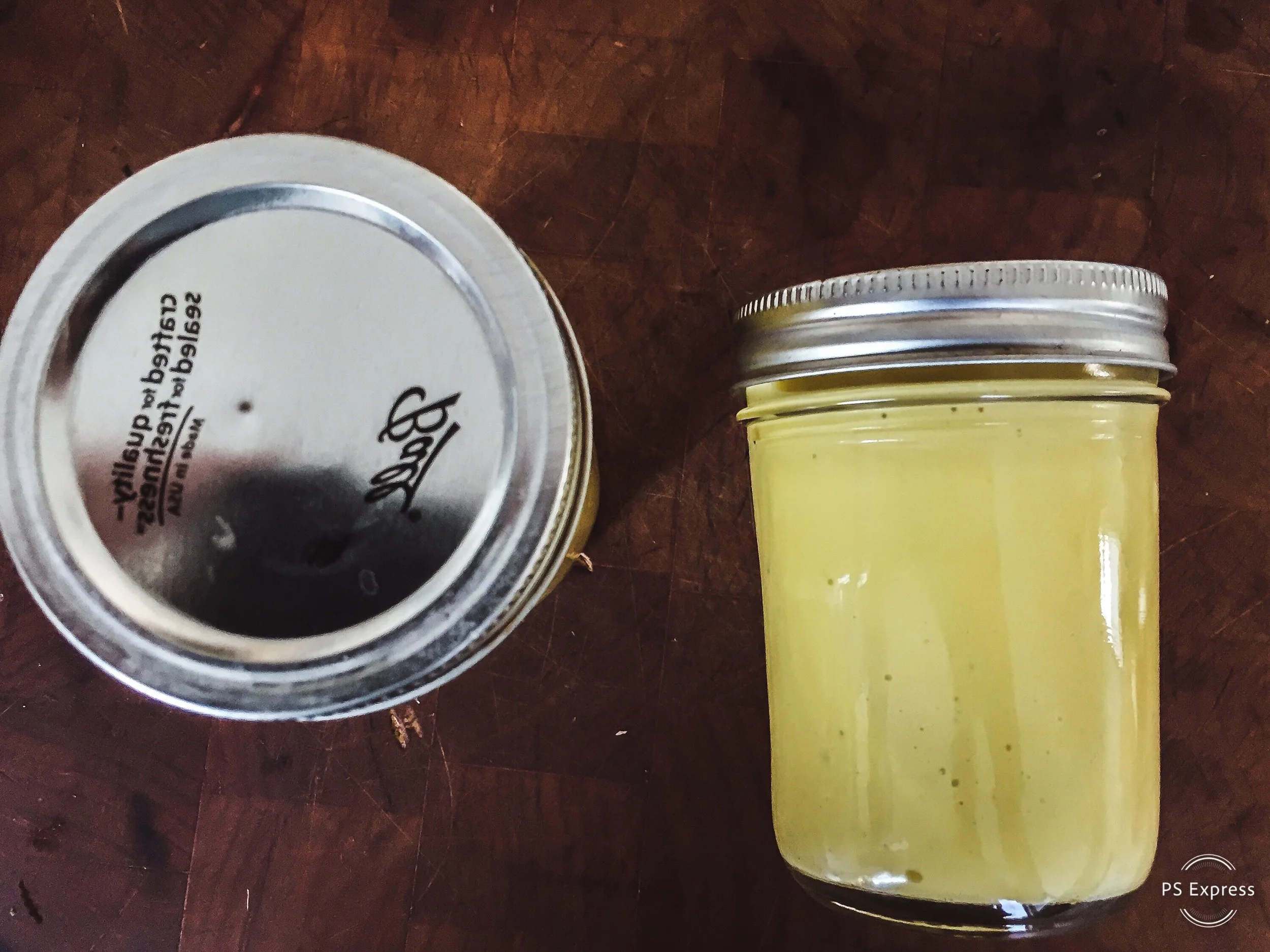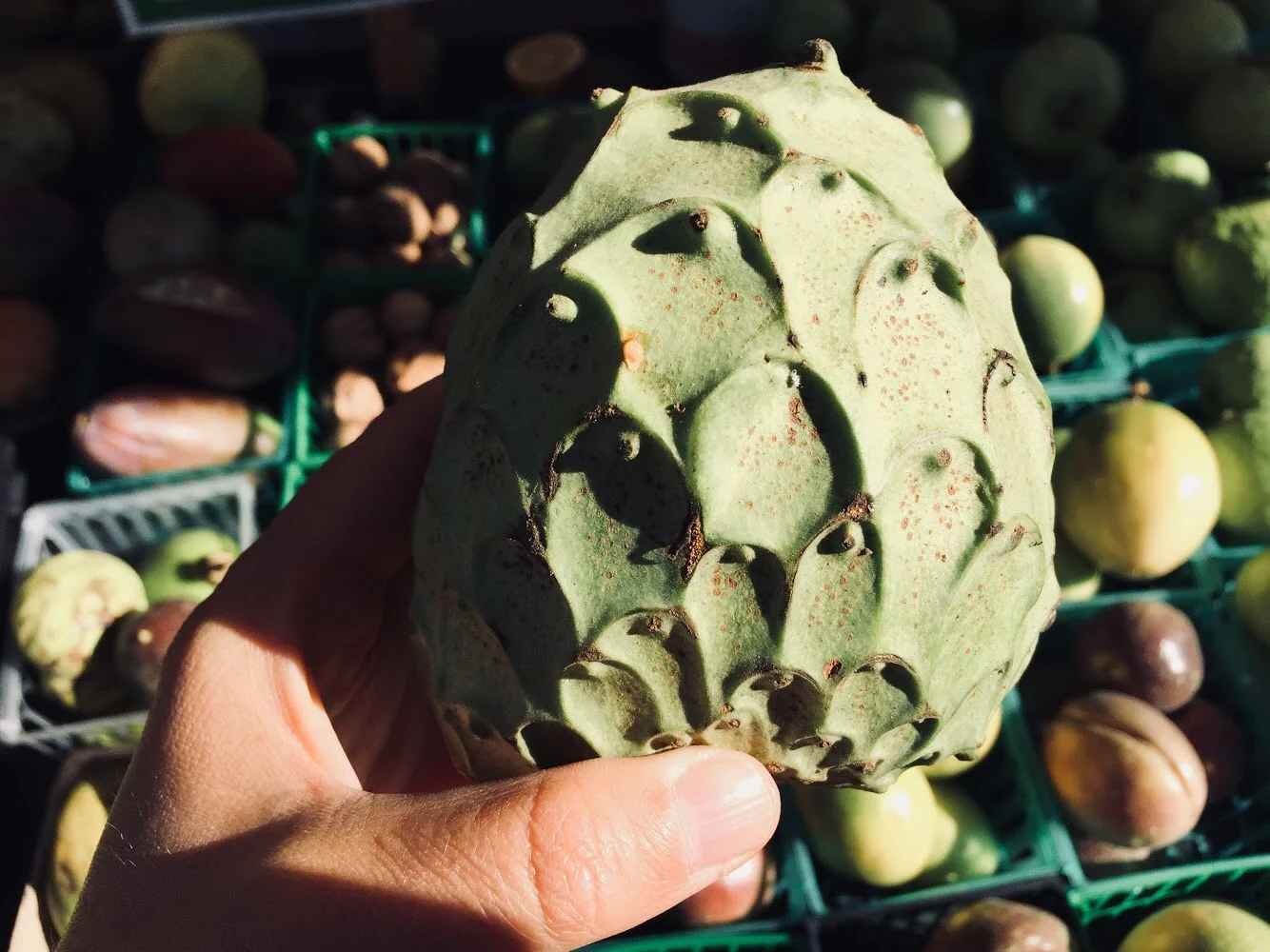Jam Making: True Confessions of a Locavore
Eating in-season doesn’t mean depriving yourself, if you preserve when the harvest is bountiful! And this Strawberry Jam with Thyme and Honey is a delicious place to start.
A couple months back, Market Manager Martha and I were invited to teach a cooking class at the Playa Vista Public Library. Our class was scheduled in the after-school bracket, and we were encouraged to make it both engaging for adults and accessible for kids. We settled on strawberry jam with thyme and honey. Strawberries are almost always in season, and jam is easy to make—but the honey and thyme in this recipe lend it sophistication. This jam will do on a PBJ, but it just begs to be paired with a bloomy rind cheese.
We decided to get our strawberries from C&L, thyme from Backyard Organic, our honey from LSG, and a lemon (to balance out the flavor) from Pedro's.
Pectin, a fiber found in the cell walls of many plants, is what gives jams their sticky consistency. Strawberries don't have much—but apples do! We got apples from YNT and practiced simmering their peels until our jam jelled, and the strawberry-honey-thyme balance was something we wanted to show off. We and our jam were set.
And then it started raining, torrentially.
Many foodies (of which, I'm one) will tell you never to wash a strawberry. With a thin, porous skin, they're little fruit sponges. When they get washed, or rained on, they get water logged, go bland. When they stay wet for days on end their flavor wains, drains, and they rot. The purpose of this jam class was to showcase cooling with local produce, but after five days of heavy rains, there wasn’t a fresh pint of strawberries to be found in local markets. But purchasing berries from the supermarket felt like a betrayal. We were beginning to despair, and then we checked our freezers!
Both Martha and I are in the habit of buying extra, and preserving produce. Together, we had enough frozen strawberries to make a large batch of jam! Whats more, having been frozen at their prime, they were bursting with flavor. Eight showed up for our jam making class in the library, and after stirring and chopping, each took home a jar of local jam: all because we planned ahead.
It's April again, and—again—it's easy to be a locavore. The sun is shining, she skies are blue, and artichokes and asparagus are popping up in farmers' markets. This is the time—just weeks out of winter—to think of the future. This week at the farmers’ market, I’m planning to buy an extra pint of strawberries, an extra bunch of asparagus, and an extra bag of fava beans, to pickle or preserve or stick in the freezer for a rainy day. Being a locavore doesn't have to mean going without. You can have your favorite produce all year long (and eat it too), as long as you prepare.
STRAWBERRY THYME JAM
Adapted from thekitchn.com
Makes 1 pint
INGREDIENTS
1 quart organic strawberries (approximately 3 cups)
3/4 cup honey
5 sprigs thyme
Peels from two organic apples
Squeeze of lemon
INSTRUCTIONS
Place a saucer or small plate in the freezer
Wipe strawberries with damp towel (avoid rinsing if possible). De-stem strawberries, halve them and crush them with your fingers.
Peel apples (aim for broad, thick peels that will be easy to remove from the jam later)
Strip thyme leaves from stem
Put strawberries, honey, apple peels, thyme and lemon in copper or stainless steel pot over high heat. Mash with potato masher until strawberries are evenly smashed
Bring to a bubble and cook over high heat for 6-10 minutes, stirring often. If you have a candy thermometer, we are looking for the jam to reach 210ᵒ, if not perform the plate test!
(This trick comes from jam master Jessica Koslow’s cookbook, “Everything I want to Eat, Sqirl and the New California Cooking.”) Spoon a dollop of jam on a frozen saucer and put it back in the freezer for one minute. Swipe your finger through the jam. If the jam parts and does not run back together — it’s ready! If not, keep put the plate back in the freezer, keep cooking the jam, try again in a few minutes.
When the plate test tells you you’re done, pick apple peels out of jam with a fork, and funnel hot jam into a clean pint jar. Your jam will keep for months in the fridge!
Aubrey Yarbrough is the Community Development Manager for Farmer Mark. Before moving to LA she ran her own organic farm and cooked on the garde manger station of the award winning Elements restaurant in Princeton, NJ. She has contributed poetry to New American Writing and prose to Edible Jersey.
Brothers Products : Notes from a Hummus Snob
Authentic hummus in LA? You can get it at the Hermosa Beach Farmers’ Market!
I didn’t use to buy pre-packaged hummus. Ever.
Don’t get me wrong, I love hummus, but after five years of living in the Middle East, the region spoiled me. It turned me into a hummus addict and a hummus snob. State-side, I find prepackaged hummus to have an off-putting, acidic tinge. The chickpeas are stale, the garlic is strong. In the middle east the chickpeas, tahini, lemon, olive oil, salt, and garlic are whipped until the individual components are almost undetectable. You’re less aware of any one ingredient, and the resulting dip is more compelling. Authentic hummus is deceptively simple, and surprisingly hard to come by in America.
Those of us who have tasted the genuine article in its region of origin, are left condemned to make our own, or live with an unrequited longing for this simple salata.
...Or so I thought before I tasted Brothers hummus.
When I moved to LA this past August, I left my food processor in storage. I was new in town and needing a hummus fix, but I didn’t have the tools to make my own. So when I saw the Brothers Products stand at the Hermosa Beach farmers market, I sampled out of desperation.
And what I tasted brought tears to my eyes. For a brief instant, I was transported to a little stone cafe in the Arab quarter of Jerusalem. I could almost hear the call to prayer.
Emran, the man behind the Brother’s booth, saw that I was moved and began to reminisce. He'd first sampled Brother’s hummus five years earlier and said the taste, “took me back home.” No restaurant or store-bought product compared. “Brothers is the best in LA,” he said. I have to agree.
It’s now been six months since my move to LA. I’ve had my food processor for months, but I haven't yet made one batch of hummus. I don't have to. I get the real deal every week at the Hermosa Beach market.
You can try a sample any Wednesday, from 1pm-6pm on the Hermosa Beach Pier Plaza.
Aubrey Yarbrough manages the Playa Vista, Westwood and Hermosa Beach Farmers' Markets for Farmer Mark. Before moving to LA she ran her own organic farm and cooked on the garde manger station at the award winning Elements restaurant in Princeton, NJ. She has contributed to Edible Jersey and her poetry will appear in the forthcoming issue of New American Writing.
My Favorite Health Food is Mayonnaise.
Can mayonnaise be health food? Market Manager Aubrey thinks so! Find out why!
I love mayonnaise. The, velvety emulsification of egg yolks and olive oil is both versatile and fancy, both haute cuisine and healthy. Why not? Scientists and nutritionists agree, egg yolks and olive oil are good for you. And whisking them together with a squeeze of lemon and a dollop of dijon doesn’t change that.
I know what you're thinking. Mayo has a nasty reputation, and for some good (and some not so good) reasons. The conventional condiment—made of vegetable oil and commercially farmed eggs—is often topped off with "flavors" and calcium Disodium EDTA. I'll leave that jar on the shelf. But let's get real. The reason most of us have been shy about the white stuff can be summed up in one word: FAT. For decades we were told that eggs—rich in cholesterol—were best avoided. And that oil, regardless of its type, was bad news.
It turns out we were wrong. Nutritionists now recognize that healthy fats are an important part of a balanced diet. Some suggest that healthy fats (like egg yolks and olive oil) might even help certain people lose weight! Drumroll: Mayo!
I make my homemade mayo as they do in the South of France, with extra virgin olive oil and with lemons! And because I use free-range, farmers’ market yolks, it turns a delicious golden hue. Buon Gusto's olive oil adds a spicy kick and lemon provides a fruity tang. Added bonus: nearly everything in this recipe be found locally at the farmers market!
RECIPE
2 free range egg yolks, separated
1 cup Buon Gusto olive oil (available at our Playa Vista market)
1/2 tsp salt
lemon juice, (start with 1/2 lemon, more to taste)
1 tsp good dijon (optional)
TECHNIQUE
Great mayo is a matter of technique. You can use a whisk in a pinch, but I recommend using electric beaters if this is your first time.
Place egg yolks, lemon juice, and dijon in a medium sized bowl. Beat with electric beaters until combined. With the beaters on high, drizzle olive oil in a thin steady stream, over the beaters. Adding the oil, veeeeery slowly, is the one and only trick to making great mayo. As you add the oil, the mixture will thicken and the color will fade. When your mixture is stiff, you're done! At this point taste and add salt accordingly. You also might want to add more lemon or dijon, depending on your preferences.
FIX BROKEN MAYO
If you find that your mayo has separated—don't despair! Here's a secret: it's easier to fix broken mayo than it is to make mayo right the first time! Take your broken mayonnaise mixture and pour it into a liquid measuring cup, or any bowl with a spout that's easy to pour from. Use a rubber spatula to get all that eggy oil out of the mixing bowl and set the broken sauce aside. Now, separate another egg, and drop the yolk in your mixing bowl. From this point on, it's just like before. You're going to whisk the yolk quickly and drizzle slooooowly, BUT in place of olive oil, drizzle your broken mayo mixture. Beat the egg yolk on high and slowly pour the broken mayo over the beaters in a thin, steady stream. The broken mixture and your mayo will come together in no time! Once it has a uniform consistency and an opaque color, proceed with olive oil, completing the original recipe, adding up to an additional cup of olive oil to balance the extra yolk. You'll probably want more lemon and dijon too, but taste first to be sure.
VARIATIONS…because mayo is versatile!
* Mexican Fusion Mayo: make the spread with Buon Gusto's Cilantro Jalapeño olive oil!
* Aioli: omit lemon, add garlic and voila!
* Cesar Salad Dressing: add anchovies and a touch more dijon and lemon! Whip to a semi-loose consistency. Whisk in grated parmesan to finish.
* Traditional American mayo: substitute neutral tasting avocado oil and use distilled vinegar in place of lemon.
Celebrate healthy fats!
And don't feel guilty!
Aubrey Yarbrough is the Community Development Manager for Farmer Mark. Before moving to LA she ran her own organic farm and cooked on the garde manger station of the award winning Elements restaurant in Princeton, NJ. She has contributed poetry to New American Writing and prose to Edible Jersey.
Just a Teaspoon of Honey
What is the value of a teaspoon of honey? Robin of LSG Honey increases our appreciation for honey with one surprising fact.
How much honey does one bee make in its whole life? The answer may surprise you, unless you’ve met Robin Ghermezi, the apiarist and educator behind LSG Honey.
Robin Ghermezi became a beekeeper after retiring from the tech industry. He’s now been collecting honey for six years, but he still exudes the zeal of a recent convert. At the market, he’s generous with his honey samples, and if you linger long enough at his booth, he might convince you that bees are among the most fascinating creatures on earth.
When I approached his stand at the Playa Vista market on a recent Saturday, he was handing a spoonful of honey to a dazed looking customer.
“Wait,” the man said, “you’re telling me one bee makes a quarter teaspoon of honey…” he looked to the woman by his side in disbelief, “in its whole life?”
Robin grinned as he nodded.
“That means,” the man went on, “that the honey left on my spoon each morning…that’s like, one bee’s whole life’s work?” Robin was still smiling as he reached into a jar, producing a sample of honey for me to taste. It was buckwheat, the color of weak coffee and just a touch bitter: a perfect pairing for stinky cheese. I popped the sample in my mouth and for just a moment, I felt luxurious.
Robin produce more samples for me to try—avocado, wildflower, and a mesquite honey that tasted herbal and faintly smoky—and I lingered in his stall, eavesdropping on the customers beside me. They were strategizing. Robin’s story had transformed the honey in their hands into something valuable-verging-on-precious. They were determined never to waste another drop. Should they use a spoon or a wooden honey dipper? Should they leave the dipper in the honey jar permanently so it wouldn’t need washing—but what about ants?
Robin was unfazed. “One solution,” he said, shrugging, “is to drill a hole in to top of a honey jar, and poke the handle of the dipper stick through it.” Then he handed me a spoonful of lavender honey and began to laugh, conceding that they weren’t the first customers to respond to his fact with awe. At one point, so many customers were concerned about wasted honey, Robin was bringing a drill to the market, tricking-out honey jars so dippers could live in them.
The price of honey had not risen during this exchange, but it had, for me, grown vastly more valuable. For just one taste of honey, a foraging bee spent her days sipping nectar from flowers. She ferried it back to her hive in her tiny crop and, mouth to mouth, passed the nectar to a processor bee. In turn, the processor bee passed the nectar to another processor, mouth to mouth, in an intimate fire-line. Along the way, enzymes from each bee’s crop, mixed with the nectar making it shelf-stable. When the nectar was finally packed into a waxy cell, the bees fanned it with their wings, evaporating excess water, and nectar became honey. Robin tended the hive, carefully, skimmed off just enough honey, to share with us. We can put it in our tea, use it baking, or simply taste it by the teaspoon and marvel.
LSG hives are never treated with chemicals. Their bees collect nectar in nature and produce honey in their hives, one teaspoon at a time, as bees have been doing for a very long time. You can meet Robin and sample LSG honey at the Playa Vista Farmers’ market every Saturday from 9am-2pm.
Aubrey Yarbrough is the Community Development Manager for Farmer Mark. Before moving to LA she ran her own organic farm and cooked on the garde manger station of the award winning Elements restaurant in Princeton, NJ. She has contributed poetry to New American Writing and prose to Edible Jersey.
New Year, New Perks
Our I Love My Market Card is putting market money in your pocket! Read more about how it works or stop by the info tent at the next market!
A New Year is a great time to build healthy habits! We at Farmer Mark, are here to help you turn your resolution into a lasting change. Introducing I HEART MY MARKET rewards cards!
Now, you can get an I Love My Market Card at our info tent at each of our market locations.
Pick up a card FOR FREE at the market. Get get your card punched each time you visit the market, and on your fifth visit, we'll give you $5 Farmer Mark Bucks, redeemable with any of our vendors!
When you have all 5 visits checked off, it’s time to get a new card and keep checking off visits!
How's that for encouraging your healthy habits?!
Recap:
5 visits = 5 Farmer Mark Bucks
Get your card punched each time you visit the market
Limit one punch per day
Once your card is full, grab a new one!
It’s our thanks to YOU.
Introducing Cherimoya: Your New Favorite Fruit
The Cherimoya fruit is the offspring of a hermaphroditic flower AND Mark Twain celled it "the most delicious fruit known to men. But that’s not all…
The cherimoya (cher-uh-MOY-uh) is a fruit of curious contradictions. It's native to cold, high altitude regions—of the tropics. In fact, its name comes from the Quechua word "chirimuya," which means "cold seeds," as the seeds germinate in altitudes up to six thousand feet. And that's just the beginning...
The flower that begets this fruit is hermaphroditic.
The flower that begets this fruit is hermaphroditic. It begins its life female and within a matter of hours, transitions to male. This f-to-m transition keeps the flower from self-pollinating. By the time the pollen is produced, the ovum has withered. Bees not are not pollinator for cherimoyas. In the wild, Scientists believe a beetle makes the match, collecting pollen from male stamens, and delivering it to female ovums before they transition. When they’re cultivated outside their natural habitat, each flower has to be pollinated by hand.
And it's worth it! This is a fruity-tutti tropical explosion! Mark Twain called the cherimoya, "the most delicious fruit known to men." We agree but, ahem, women like them too.
But steer clear of the seeds. They're poisonous!
You can find cherimoya at Pedro's Organic Ranch stand. Their season starts in late fall and runs through spring.
Aubrey Yarbrough is the Community Development Manager for Farmer Mark. Before moving to LA she ran her own organic farm and cooked on the garde manger station of the award winning Elements restaurant in Princeton, NJ. She has contributed poetry to New American Writing and prose to Edible Jersey.
Farmers Market 101: Market Tips
There are many tips and tricks to smart shopping at the farmers’ market. These tips allow you to get the biggest bang for your buck, and have the best experience possible. We’re letting you in on a few of our top tips. Keep these in mind next time your shopping at your local farmers’ market.
There are many tips and tricks to smart shopping at the farmers’ market. These tips allow you to get the biggest bang for your buck, and have the best experience possible. We’re letting you in on a few of our top tips. Keep these in mind next time your shopping at your local farmers’ market.
- Early Bird Gets the Worm: This is one of our most important tips. If the market opens at 9, get there at 9! Being one of the first customers will allow you to pick from the farmers’ full selection. You might be missing out on an incredible item that always sells out within the first hour.
- Go Big: Why not buy a whole flat of tomatoes or strawberries? If one of your favorite fruits or vegetables is in season and is looking juicy and delicious, go for it. You can always freeze or can them! Buying in bulk can often come with a nice discount. Politely ask the farmer about bulk deals available.
- Experiment: We all have our favorite farmer at a specific market, but don’t forget to explore. Challenge yourself to try at least one new vendor each week at your market. You might just find your new favorite item.
- Get Friendly: Farmers sell at the market not only to share their crops, but to get to know their customers! They love interacting and answering your questions, so don’t be shy! If your curious about their farming practices or what a certain crop is, go ahead and ask them! TIP: Remember your vendor’s name the following week and greet him with a friendly, “Morning, (insert name)!”
- Bring the Green: Most farmers operate on a cash only basis, so don’t forget to stop at an ATM before heading to the market. And keep in mind that small bill work best.
Farmers Market 101: 5 Questions to Ask Your Farmer
Food plays a huge role in health and well-being, so it is important to get the quality you deserve. Frustratingly, it’s often difficult to get questions answered from your local restaurant or grocery store. I know my questions to waiters are often received with a glare of inconvenience. Fortunately, the local farmers’ market is a different story.
Food plays a huge role in health and well-being, so it is important to get the quality you deserve. Frustratingly, it’s often difficult to get questions answered from your local restaurant or grocery store. I know my questions to waiters are often received with a glare of inconvenience. Fortunately, the local farmers’ market is a different story.
Farmers’ market vendors love inquisitive customers so ask away. Don’t know what to ask? We can help. Firstly, remember that no genuine question is a bad question, so don’t be shy!
We like to keep things simple so we stick with the 5 W’s (the good ole’ who, what, where, when & why).
Who is the farmer?
What chemicals, if any, were used?
Where is the farm located?
When was the produce picked?
Why should or shouldn’t I buy organic?
Bonus Questions – the How:
How do I pick the best one?
How do I prepare this?
How do I store this?
With questions like these, you’ll quickly find the farmers’ market is not just a place to pick up your groceries. It’s a place to cultivate relationships with your food sources. Next time you are at your local farmers market, spend an extra minute to inquire about your purchase. We know they will appreciate your curiosity and will likely remember you the next time you come to see them!!
Farmers Market 101: What is a GMO?
There is plenty of talk about GMO’s lately, especially in relation to states trying to pass laws requiring labeling of them. Struggling with understanding GMOs? Here is a quick 5-point primer for you.
There is plenty of talk about GMO’s lately, especially in relation to states trying to pass laws requiring labeling of them. Struggling with understanding GMOs? Here is a quick 5-point primer for you.
1. What does GMO stand for?
Genetically Modified Organism
2. What does Genetically Modified mean?
This means a plant or animal has been genetically engineered using DNA from bacteria, viruses or other plants and animals (important to note that these are changes that could not happen in nature, which differentiate GMOs from traditional crossbreeding). For example, GMO scientists inserted DNA from an Artic fish into the DNA of a tomato giving the tomato an improved tolerance to cold temperature.
3. How did GMOs come about?
GMOs came about from chemical companies desire to sell more pesticides/herbicides to farmers by eliminating the fear of killing crops during application. Therefore, they engineered the crops to tolerate the direct application of herbicides and pesticides.
4. Why should I care about GMOs?
Health concerns. More than 60 countries have restricted or banned GMOs due to health concerns. There are no long-term health studies indicating their safety while growing evidence supports the connection between GMOs and health problems such as autoimmune diseases and cancer. The food industry (in the US) says otherwise but keep in mind that our FDA allows our food to be modified based on testing done by the same corporations creating them (huge conflict of interest).
5. How can I avoid GMOs?
It’s very difficult. Chances are when eating out at a restaurant, your plate is filled with GMO ingredients. The most common GMOs in the US are corn, canola, soy, sugar beets and cotton. In the US, GMOs are used in about 70% of conventional processed foods. Since labeling is note required, it makes it very difficult to avoid them. To date, every State ballot initiative to label GMOs has been defeated thanks to the financial backing from corporations benefiting from GMOs.
Practical Takeaways.
Although it may be time consuming, doing research is key. Labels such as Organic and the voluntary “Non-GMO” will let you know its GMO free. Otherwise, it’s best to buy from local farmers’ markets and small local companies. Eating local, organic vegetables and organic, grass-fed meat and poultry will keep you on the right track. We know that things can get expensive, so we always suggest to do the best you can within your means.
If you’re interested in even more reading and joining the Non-GMO Project, click here.
Farmers Market 101: Market Faux-Pas
We’ve already discussed our top tips and tricks to get the most of your farmers’ market experience. Next up is our advice for what not to do at the market! Every market is different and unique, but these tips go for all markets across the board. Being mindful of the following will make each and every farmers’ market that more enjoyable for everyone! Here are our top 5 no-no’s:
We’ve already discussed our top tips and tricks to get the most of your farmers’ market experience. Next up is our advice for what not to do at the market! Every market is different and unique, but these tips go for all markets across the board. Being mindful of the following will make each and every farmers’ market that more enjoyable for everyone! Here are our top 5 no-no’s:
- Don’t over bargain: Bargains are all around the farmers’ market. From free samples, rounding down of transaction totals and the occasional free extra piece of produce, generosity abounds. Be grateful and don’t try to take advantage of the generous and casual nature of your farmers. They work extremely hard to provide the freshest and most nutritious food, and deserve every penny, which represents an investment in your community and local food system.
- Don’t be in a rush: Life is sometimes crazy, and we understand that we live in a fast paced environment. However, one of the main charms of a farmers’ market is its slow, leisurely place. It’s an outdoor area meant for community gathering and relaxation, so give yourself time to walk around, talk to farmers and neighbors, and pick your perfect produce.
- Don’t litter: Samples often come with a toothpick or mini cup. Avoid the easy temptation to toss it (or the remains of that strawberry top) on the ground. Be respectful to the market and the earth by placing trash in the bins.
- Don’t be above market regulations: Market staff loves your pet but we have a duty to make sure the market is compliant with all health and agriculture department regulations. Don’t get upset when we ask you to obey them too. Unfortunately, pets are currently not allowed. Your pet is adorable but if it comes in contact with a vendor’s produce that vendor must toss it out, resulting in a loss of income.


















































